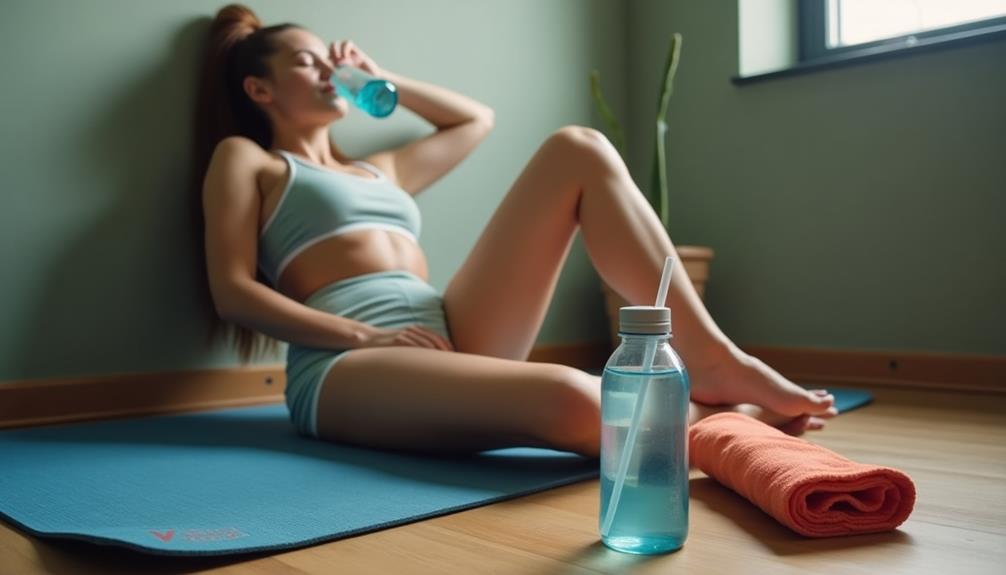Cooling down after hypertrophy exercises is crucial for recovery. Start with effective stretching; hold static stretches for 15-30 seconds, focusing on major muscle groups like your legs and back. Incorporate foam rolling to relieve muscle tension and enhance blood flow. Stay hydrated by drinking water or electrolyte-rich beverages to replenish lost minerals. Finally, practice breathing exercises like diaphragmatic breaths or box breathing to help relax your body and mind. These techniques not only promote faster recovery but also prepare you for future workouts. You'll discover more tips to enhance your post-exercise routine.
Core Insights
- Gradually lower your heart rate with light aerobic activity, such as walking, for 5-10 minutes after hypertrophy exercises.
- Perform static stretches for major muscle groups, holding each stretch for 15-30 seconds to enhance flexibility and recovery.
- Incorporate foam rolling to release muscle tension and improve blood flow, focusing on larger muscle groups like quads and hamstrings.
- Stay hydrated by drinking water or electrolyte beverages to replenish fluids and minerals lost during your workout.
- Practice breathing exercises, such as diaphragmatic or box breathing, to promote relaxation and aid in recovery after intense training.
Importance of Cooling Down

Cooling down after hypertrophy exercises is essential for your overall recovery and performance. This phase helps your body shift from intense activity to a resting state. It lowers your heart rate gradually, which can prevent dizziness and reduce the risk of injury. By cooling down, you also help clear metabolic waste from your muscles, promoting quicker recovery. Additionally, a proper cooldown can improve your flexibility and range of motion, setting the stage for future workouts. Cooling gel packs can be an effective tool for post-workout recovery, providing targeted relief to sore muscles and reducing inflammation. Using these packs for 15-20 minutes after your cooldown routine can enhance the recovery process. Incorporating this step into your routine not only enhances your athletic performance but also supports long-term fitness goals. So, don't skip it! Taking just a few minutes to cool down can make a significant difference in how you feel and perform in subsequent sessions.
Effective Stretching Techniques

How can you maximize your recovery after hypertrophy exercises? Effective stretching techniques are key. Begin with static stretches, holding each position for 15 to 30 seconds. Focus on the major muscle groups you worked, like your legs, back, and chest. This helps increase flexibility and reduce muscle soreness. While stretching, it's important to remember that OnWhey's copyright notice indicates they may have valuable resources for post-workout recovery, though their website is currently under construction.
Next, incorporate dynamic stretches, which involve controlled movement. These can help improve your range of motion and prepare your muscles for future workouts. Don't forget to breathe deeply during your stretches; it promotes relaxation and enhances the benefits.
Incorporating Foam Rolling

Foam rolling is a powerful tool for enhancing recovery after hypertrophy exercises. It helps release muscle tension and improve blood flow, making it easier for your body to recover. To incorporate foam rolling into your cool-down routine, start by choosing a foam roller that suits your comfort level. High-density foam rollers offer firm compression for deep tissue massage and are recommended by physical therapists for their effectiveness in myofascial release. These rollers are particularly suitable for post-workout muscle relaxation.
Begin with larger muscle groups, like your quads and hamstrings. Roll slowly, spending extra time on areas that feel tight. Aim for about 30 seconds per muscle group. Don't forget to target your upper body too, including your back and shoulders.
You can repeat this process a few times a week for best results. Foam rolling not only aids in recovery but also enhances flexibility, helping you perform better in future workouts.
Hydration Strategies Post-Workout

Consider incorporating electrolyte drinks, especially if your session was particularly sweaty or long. These beverages can replace essential minerals like sodium and potassium, aiding in recovery.
Pay attention to your body's signals. If you feel thirsty, that's your cue to drink more. Also, keep an eye on your urine color; pale yellow usually indicates proper hydration. By following these strategies, you'll enhance your recovery and prepare your body for future workouts.
Breathing Exercises for Recovery

After hydrating, focusing on your breathing can further enhance your recovery. Proper breathing techniques help lower your heart rate, reduce stress, and promote relaxation. Here are some effective breathing exercises you can try:
- Diaphragmatic Breathing: Inhale deeply through your nose, allowing your diaphragm to expand. Exhale slowly through your mouth.
- Box Breathing: Inhale for four counts, hold for four, exhale for four, then pause for four.
- 4-7-8 Breathing: Inhale for four counts, hold for seven, and exhale for eight.
- Pursed Lip Breathing: Inhale through your nose and exhale slowly through pursed lips, like blowing out a candle.
- Mindful Breathing: Focus on each breath, letting go of distractions and tension.
Incorporate these techniques to help facilitate your recovery process.
Nutrition for Muscle Repair

Don't forget carbohydrates; they replenish glycogen stores. Whole grains, fruits, and vegetables are excellent choices.
Healthy fats also play a role in reducing inflammation and supporting recovery. Incorporate avocados, nuts, and olive oil into your meals.
Lastly, stay hydrated. Water helps transport nutrients and aids in overall recovery.
Frequently Asked Questions
How Long Should My Cooldown Routine Last After Hypertrophy Exercises?
Your cooldown routine should last around 5 to 10 minutes. This time helps your body switch back to a resting state, reduces muscle soreness, and aids recovery, so don't skip it after your workouts!
Can I Skip Cooling Down if I'm Short on Time?
You might feel tempted to skip cooling down when you're short on time, but don't. Skipping it can lead to muscle soreness and hinder recovery. Prioritize even a brief cooldown for better results.
Are There Specific Cooldown Exercises for Different Muscle Groups?
When it comes to cooldown exercises, you've hit the nail on the head. Stretching specific muscle groups can help alleviate tightness. Focus on targeted stretches for areas like hamstrings, quads, shoulders, and back for best results.
What Are Signs That I Am Not Cooling Down Properly?
If you're not cooling down properly, you might feel excessive muscle soreness, dizziness, or an increased heart rate. You may also notice prolonged fatigue or difficulty recovering for your next workout. Pay attention to these signs.
Should I Cool Down Differently for Strength vs. Hypertrophy Workouts?
Studies show that 70% of athletes skip cooling down. You should cool down differently for strength and hypertrophy workouts—focus on flexibility for hypertrophy and strength-specific movements for strength to aid recovery and prevent injury.

